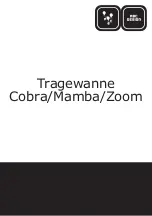
Spring Pilot Quick Test
1. Isolate the main valve from the steam line. Make sure
the internal pressure is 0 psig and allow the valve to
cool to prevent injury.
2. Disconnect the copper tubing line from the main valve
diaphragm. Point tubing in a direction to prevent
damage or burns.
3. Release compression on adjusting spring by loosening
adjusting nuts an equal amount
4. If used in conjunction with a temperature pilot, set
temperature setting higher than the bulb temperature.
5. Slightly open the shut off valve in the steam supply to
the main valve and allow pressure to build.
6. Gradually compress the adjusting spring by tightening
adjusting nuts equally until steam passes from the
open end of the copper tubing line.
• When used in conjunction with a temperature pilot,
adjust pilot temperature setting to be higher than
the bulb temperature.
• The steam flow should discharge from the tubing
line. Release some compression on the adjusting
spring to reduce the pressure and the steam flow
should stop.
• A slight leakage is OK.
• Repeat several times.
• If the pilot does not start and stop the steam supply,
the pilot should be repaired or replaced.
7. If the pilot responds properly, the problem is elsewhere
in the system
Spring Pilot Bench Tests
1. Isolate the main valve from the steam line. Make sure
the internal pressure is 0 psig and allow the valve to
cool to prevent injury.
2. Disconnect the copper tubing lines and feedback line.
Disconnect the pipe union and remove the pilots. If
more than one pilot is used, unscrewing the 1/4" NPT
pipe nipples should separate them.
3. Mount the spring pilot in a vice to test.
4. Release compression on adjusting spring by loosening
adjusting nuts an equal amount.
5. Plug the 1/4" NPT
FEEDBACK LINE
port.
6. Install a 1/8" NPT pipe with a pressure gauge and
shut off valve in the SIGNAL LINE port.
7. Connect a 30 psig air supply to the 1/4" NPT pilot
INLET
port.
8. Test for seat and disc leakage:
• Open shut off valve from
SIGNAL LINE
port.
• Apply air pressure at the
INLET
port.
• Check for leakage from the
SIGNAL LINE
port.
• If excessive leakage is indicated, replace the disc
and seat. See "Spring Pressure Pilot Repair", page 17.
9. Test for Valve movement.
• With 30 psig air pressure at the pilot
INLET
connec-
tion, close the shut off valve in the
SIGNAL LINE
pipe, and keep the
FEEDBACK LINE
port plugged.
• Adjust the spring compression loading force until
the outlet pressure is equal to 1/2 of air inlet supply.
• Slowly open and close the shut off valve in the
SIGNAL LINE
pipe several times, the pressure
should be the same each time the shut off valve is
closed.
• The pressure should respond smoothly.
• If the pressure changes each time or if the reaction
of the pressure gauge is jerky, the pilot valve
movement is restricted.
• Inspect the internal components for dirt or wear.
Replace parts necessary. See "Spring Pressure
Pilot Repair."
10. Diaphragm test.
• With 30 psig air pressure at the pilot
INLET
connec-
tion, close the shut off valve in the
SIGNAL LINE
pipe, and keep the
FEEDBACK LINE
port plugged.
• Adjust the spring compression loading force until
the outlet pressure is equal to 1/2 of air inlet supply.
• Check for air leakage around the diaphragm under
the adjusting spring and pressure plate.
• If air is leaking, replace the diaphragms. See
"Spring Pressure Pilot Repair", page 17.
Close all steam lines that could pressurize any of the valve chambers before disassembling the system. Use caution
when opening any section or valve chamber as there may be hot condensate trapped inside. Failure to do so may
result in burns.
!
CAUTION
Quick test is done using live steam. Point tubing in a
direction to prevent property damage or burns. To prevent
serious burns, wear heat resistant gloves. Failure to fol-
low this warning may result in property damage, personal
injury or death.
!
CAUTION
PILOT VALVE TESTING AND REPAIR
SPRING PRESSURE PILOT
16









































